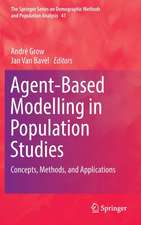Colonization and Development in New Zealand between 1769 and 1900: The Seeds of Rangiatea: Demographic Transformation and Socio-Economic Development, cartea 3
Autor Ian Poolen Limba Engleză Hardback – 12 sep 2015
The book focuses on, and synthesizes, the most critical parts of the story, the health and population trends, and the economic and social development of Maori. It adopts demographic methodologies, most typically used in developing countries, which allow the mapping of broad changes in Maori society, particularly their survival as a people.
The book raises general theoretical questions about how populations react to the introduction of diseases to which they have no natural immunity. Another more general theoretical issue is what happens when one society’s development processes are superseded by those of some more powerful force, whether an imperial power or a modern-day agency, which has ingrained ideas about objectives and strategies for development. Finally, it explores how health and development interact.
The Maori experience of contact and colonization, lasting from 1769 to circa 1900, narrated here, is an all too familiar story for many other territories and populations, Natives and former colonists. This book provides a case-study with wider ramifications for theory in colonial history, development studies, demography, anthropology and other fields.
| Toate formatele și edițiile | Preț | Express |
|---|---|---|
| Paperback (1) | 643.65 lei 6-8 săpt. | |
| Springer International Publishing – 22 oct 2016 | 643.65 lei 6-8 săpt. | |
| Hardback (1) | 650.04 lei 6-8 săpt. | |
| Springer International Publishing – 12 sep 2015 | 650.04 lei 6-8 săpt. |
Preț: 650.04 lei
Preț vechi: 764.76 lei
-15% Nou
Puncte Express: 975
Preț estimativ în valută:
124.39€ • 133.01$ • 103.71£
124.39€ • 133.01$ • 103.71£
Carte tipărită la comandă
Livrare economică 17 aprilie-01 mai
Preluare comenzi: 021 569.72.76
Specificații
ISBN-13: 9783319169033
ISBN-10: 3319169033
Pagini: 305
Ilustrații: XXVIII, 335 p. 6 illus.
Dimensiuni: 155 x 235 x 27 mm
Greutate: 0.69 kg
Ediția:1st ed. 2015
Editura: Springer International Publishing
Colecția Springer
Seria Demographic Transformation and Socio-Economic Development
Locul publicării:Cham, Switzerland
ISBN-10: 3319169033
Pagini: 305
Ilustrații: XXVIII, 335 p. 6 illus.
Dimensiuni: 155 x 235 x 27 mm
Greutate: 0.69 kg
Ediția:1st ed. 2015
Editura: Springer International Publishing
Colecția Springer
Seria Demographic Transformation and Socio-Economic Development
Locul publicării:Cham, Switzerland
Public țintă
ResearchCuprins
Chapter one: A History of Survival and Resilience.- Chapter two: Maori Resource Loss & Development.- Chapter three: Colonisation and Maori.- Chapter four: Populations and Their Wellbeing.- Chapter five: The Wider Historical Context- Chapter six: Contact, Interaction & their Impacts.- Chapter seven: Demographic Ephemera, 1769-1840.- Chapter eight: Significant Determinants of Population Change: Disease & the 'Musket Wars'.- Chapter nine: Maori Demography and the Economy to 1840.- Chapter ten: Maori Resourse Loss, Pakeha 'Swamping'.- Chapter eleven: Moari: The 'Dying Race'; Pakeha:Surgent.- Chapter twelve: Factors Affecting Maori Survival, 1840-1901.- Chapter thirteen: The Dismembering of the Maori Economy.- Chapter fourteen: Health & Wealth, Population & Development.- Chapter fifteen: Just Surviving - Not Thriving.
Textul de pe ultima copertă
This book details the interactions between the Seeds of Rangiatea, New Zealand’s Maori people of Polynesian origin, and Europe from 1769 to 1900. It provides a case-study of the way Imperial era contact and colonization negatively affected naturally evolving demographic/epidemiologic transitions and imposed economic conditions that thwarted development by precursor peoples, wherever European expansion occurred. In doing so, it questions the applicability of conventional models for analyses of colonial histories of population/health and of development.
The book focuses on, and synthesizes, the most critical parts of the story, the health and population trends, and the economic and social development of Maori. It adopts demographic methodologies, most typically used in developing countries, which allow the mapping of broad changes in Maori society, particularly their survival as a people.
The book raises general theoretical questions about how populations react to the introduction of diseases to which they have no natural immunity. Another more general theoretical issue is what happens when one society’s development processes are superseded by those of some more powerful force, whether an imperial power or a modern-day agency, which has ingrained ideas about objectives and strategies for development. Finally, it explores how health and development interact.
The Maori experience of contact and colonization, lasting from 1769 to circa 1900, narrated here, is an all too familiar story for many other territories and populations, Natives and former colonists. This book provides a case-study with wider ramifications for theory in colonial history, development studies, demography, anthropology and other fields.
The book focuses on, and synthesizes, the most critical parts of the story, the health and population trends, and the economic and social development of Maori. It adopts demographic methodologies, most typically used in developing countries, which allow the mapping of broad changes in Maori society, particularly their survival as a people.
The book raises general theoretical questions about how populations react to the introduction of diseases to which they have no natural immunity. Another more general theoretical issue is what happens when one society’s development processes are superseded by those of some more powerful force, whether an imperial power or a modern-day agency, which has ingrained ideas about objectives and strategies for development. Finally, it explores how health and development interact.
The Maori experience of contact and colonization, lasting from 1769 to circa 1900, narrated here, is an all too familiar story for many other territories and populations, Natives and former colonists. This book provides a case-study with wider ramifications for theory in colonial history, development studies, demography, anthropology and other fields.
Caracteristici
Adopts demographic methodologies which allow the mapping of broad changes in Maori society Questions the applicability of conventional models for analyses of colonial histories of population and development Raises more general theoretical questions about what happens when one society’s development processes are superseded by those of some more powerful force





































